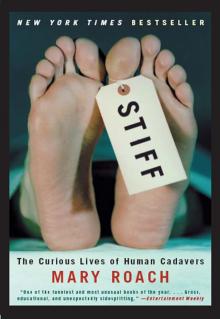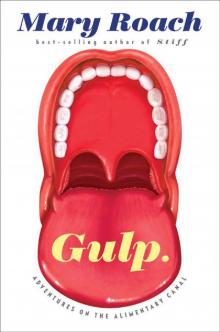- Home
- Mary Roach
My Planet: Finding Humor in the Oddest Places Page 5
My Planet: Finding Humor in the Oddest Places Read online
Page 5
“You know if you take Clipper Street,” Dan is saying, “you can shave six minutes off the drive.” These minutes go into a special account, where they can be redeemed for chest hair, leather gloves with holes cut out of the back, and other bonus masculinity awards.
“Not this time of day. That preschool lets out, and the whole right lane’s blocked.” Ed is making this up. A man will say anything to avoid being exposed as The Guy Who Doesn’t Know the Fastest Route. This is right up there, humiliation-wise, with being exposed as The Guy Who Asks for Directions. The deepest shame that can befall an American male is for a stranger in a gas station to find out that—Oh my God—you don’t know your way around a neighborhood you’ve never been to.
Meanwhile, Dan’s wife, Wendy, and I are across town in her car, trying to find our way back from a matinee. Viewed from above, our route resembles the adorable and random wanderings of a toddler’s Etch A Sketch drawings. It is not the most direct route to her house or my house or anything at all—save the mental breaking point of our husbands. But we’re fine with it. To a group of women, sitting in a car is little different from sitting in someone’s home, only with wheels and not enough closet space. We get caught up in the conversation and forget about the petty details of navigation, such as west vs. east and the like. Wendy crests a hill. “Is that the ocean? How’d we get here?”
So we park the car and go for a walk on the beach. Meanwhile, Dan and Ed have pulled over and come to blows, adding an extra four minutes and a side trip to St. Luke’s hospital to their drive time.
Sunshine on a Cloudy Day
It was April, and I was heading for Cleveland. Packing for April is tricky—could be cold, could be hot. I needed a weather report. Normally, I don’t bother with weather reports, because I employ my own personal scientific weather reporting system. This consists of a) opening the bedroom window, and b) sticking my arm out and waving it around. It’s important to wave it around, so as to get a proper air sample and to keep the neighbors wondering.
This is a roundabout way of explaining why I spent my Tuesday evening watching The Weather Channel. I thought—silly me—that this would be a channel showing nothing but weather reports. I tuned in to find a TV show in progress, called “Storm Stories.” Today’s storm story involved a bus driver in Florida, about to drive over a causeway just as a tornado was headed his way. “By the time Hugo got to the causeway …” intoned the narrator darkly. I turned to Ed. “Is Hugo the bus driver or the storm?”
“It’s not a hurricane,” said Ed. “It’s a tornado.”
“They don’t name tornadoes?”
Ed sighed.
Right about then, just as the drama was reaching its peak, the show cut away to a scene inside the Miami Weather Bureau. A guy named Dave was using a diagram with large red H’s and giant moving arrows to explain all about “sucking updrafts.” We kept waiting for them to broadcast images of the bus being sucked into the updraft and twirled around like a hamburger wrapper, but this was not to be. The Weather Channel does drama like other channels do weather. That is to say, something of an afterthought.
Then, because several minutes had passed without one, they showed a map of the United States, with shifting dryer lint superimposed on it. There’s a rule on The Weather Channel: Five minutes is too long to wait for a map of the United States with dryer lint on it. The lint corresponded to some sort of system, or “front,” that was incomprehensible to anyone outside of Weather Service employ. After 30 years of watching fronts move in off the ocean or down from Canada or what have you, I’ve figured out what it means: It means something cold and wet is going to start falling from the sky, and if it’s already falling from the sky, it’s going to stop. Why can’t forecasters just say this?
Next up was “Evening Edition,” which featured two hosts sitting at a credenza, stacking and restacking papers. They did not look like Dave, or any other weather bureau meteorologist. They looked like people who wanted to be on TV news, but did something horribly wrong and were being punished.
“In our top story, a heat wave in New York City . . .” It appeared that “Evening Edition” didn’t tell you the weather; it showed you. The screen featured a shot of people eating ice-cream cones on a Manhattan street. I tried to imagine what the stock-market report would be like if the financial channels took this approach: One shot after another of “suits” exchanging BMWs for Toyotas?
I gave up on The Weather Channel and went ahead and packed. I packed for a heat wave in Cleveland, and I packed for a blizzard. I packed boots and flip-flops and tank tops and a parka. I packed so many layers that I could no longer bring anything to read, which was fine, because I’d need those six hours in flight to berate myself for overpacking. Then I began to worry about what the airport security guard would think when he looked in my bag: “You say you’re going to Cleveland, ma’am? It’s 90˚ there. What’s the parka for?”
“Well, sir, if you watched The Weather Channel, you would know that several historic Midwest blizzards have actually happened during heat waves. You see, when a front, or ‘system,’ moves in and the dew point is very high, large red H’s and arrows begin to appear in the sky . . .”
I called my friend in Cleveland. “Do me a favor. Go stick your arm out the window.”
You Know the Drill
My husband goes to a dentist who has a TV mounted on the wall beside the chair. Ed comes home talking about the new way of preparing smelts that he saw on the Food Network while the dentist scraped tartar off his incisors. Now, thanks to Ed, I associate seafood dishes with plaque removal, and hardly ever request tartar sauce anymore.
I went to my own dentist this week, after a hiatus of some centuries, and was excited to see that Dr. Chee had installed a TV set too. An infomercial was on, all about porcelain veneers and whitening procedures and other wonderful things that your dental insurance doesn’t cover. From observing dozens of Before and After shots, I concluded that women are much better at applying makeup after they get veneers.
The hygienist was draping me with a lead bib, in case some of the X-rays dribbled onto my chest. I asked her if we could change the TV channel. She explained that it was not a TV but rather a VCR for showing videos about Dr. Chee’s new services.
Like any successful businessman, Dr. Chee is not one to pass up a revenue-generating opportunity. This is a dentist who hands out free sugar cookies in his waiting room. Dr. Chee is never all that happy to see me, because I never let him replace my fillings. If my teeth don’t hurt, I’m not messing with them.
“So,” said Dr. Chee. “What brings you here? Need a new toothbrush?”
Dr. Chee told me to watch the video monitor while he poked around in my mouth. On the screen was a closeup of some revolting discolored molars. I waited to see how the porcelain veneer folks were going to tackle this mess.
“These are your teeth.” Dr. Chee had been holding a tiny closed-circuit TV camera inside my mouth. He panned from one molar to the next, narrating in the grave, somber tones of a newscaster at the aftermath of a major natural disaster. “Pitted, corroded fillings. Cracks and fissures where the amalgam has pulled away . . .”
He could have said, “Look how nicely these fillings are holding up!” and the images—to my dentally ignorant eye—would have fit. In fact, I’d made the rounds of several other dentists in town, hoping to find one who’d say, “Look how nicely these fillings are holding up!” But they didn’t, so I went back to Dr. Chee, where at least you get cookies.
Dr. Chee said that I needed to replace fillings in three teeth and get crowns on two others. He said that a crown costs $850. I have heard of crowns costing this kind of money, but these are mostly in the Tower of London. To distract me from the bad news, he panned artfully to a medium closeup of the roof of my mouth, which he described as a “high, steep vault.”
“That’s where I keep the gold bullion I’
ll be using to pay for my dental work,” I said. Unfortunately, Dr. Chee had his hand in my mouth, as well as the hand of his lovely assistant and a Bissell dual-suction upright rug-cleaning system and another hand and a 93-piece cordless drill set and the Pensacola University Marching Band.
Consequently my witticism came out this way: “Aast aaa aah caaa aga ah ah at ah ah aaa-aa a caa-ah a ent-ull uh.” Over the years, Dr. Chee has developed a remarkable ability to understand the garbled, consonant-deprived utterances of the orally overloaded. “Ha, ha,” he replied.
Then I gave him my usual if-it-ain’t-broke line. He turned to the hygienist. “Make a note in the chart: Hold off on replacing fillings until patient’s teeth rot in mouth.”
He sounded displeased. He sounded like he wanted to send me on a short walk off a long pier with a lead bib.
“Okay, maybe one crown. Will I be better at applying makeup after the procedure?”
Dr. Chee smiled. He’s a nice guy, and he doesn’t deserve patients like me. If I were him, I’d have put my fist in my mouth a long time ago, and not to fix three fillings.
Check This Out
I’m an enthusiastic fan of the new self-check-in kiosks that the airlines have installed. Having gleefully checked myself in on many occasions, I was eager to try self-check-in’s retail cousin, self-checkout. The local Home Depot has four such devices, and last weekend my husband and I paid a visit.
From our cart, Ed handed me one of seven identical piping clamps. I whisked the UPC code over the scanner as I’ve seen the pros do. Nothing. Ed fished a different clamp from the cart and ran it over the scanner successfully, establishing a baseline of resentment and rancor for our self-checkout experience.
Since the machine seemed to respond to this particular clamp, Ed suggested passing it over the scanner seven times rather than struggling to make the scanner register the UPCs of the other six. The machine took issue with Ed’s sensible and innovative checkout strategy.
“Please Place Item in Bagging Area.”
“Why?” replied Ed, and here was the start of his undoing. A talking machine will talk to you—endlessly, bossily, repetitively—but it will not, no matter how fascinating or urgent your words, listen to you. It is my belief that these machines infuriate men because they remind them of the less pleasing aspects of talking to their spouses.
“Please Place Item in Bagging Area.”
I put a bag onto the bag holder, and Ed dropped the six clamps into it. Now the machine had a new gripe. “Unexpected Item in Bagging Area. Please Remove Item.”
As it turned out, there was a scale underneath the bagging area, enabling the machine to ensure that the two-ounce clamp you scanned is exactly what goes into the bag, rather than the two-ounce clamp plus the Makita cordless drill kit you are endeavoring to steal.
From the cart, Ed next picked up an eight-foot length of conduit pipe. The UPC code sticker had been placed midway along the shaft. Scanning the thing would entail knocking over a display caddy of roofing tiles and Roof Wear Warning Signals (“1. Loose granules . . .”) located on the far side of the machine, while simultaneously tripping up customers passing by behind us.
At a store that sells lumber and toilets and bags of cement, self-checkout isn’t a convenience—it’s a Chevy Chase movie.
Ed was perturbed, and this takes some doing. Ed is the most level-headed person I know. You could take one of the carpenter’s levels from Aisle 5 and place it on his head and the little bubble will always be right there in the middle. I mention this by way of explaining why it was that at this particularly tense juncture, I chose to further aggravate my husband by idly asking what’s inside the little bubble on a carpenter’s level.
Ed looked as if he was trying to decide who—me or the machine—more clearly deserved to have their granules whacked loose with a conduit pipe.
“Liquid,” he said, in a not overwhelmingly cordial tone.
In any other store, I might have stalked off to go flirt with the customers. This isn’t possible at Home Depot. A man in Home Depot can’t even see a woman.
A woman appeared at our side with a handheld scan gun and a marriage counselor. She explained that self-checkout was for small items only, and then she scanned the piping and reset the machine. Though self-checkout has enabled Home Depot to hire fewer checkout clerks, it has had to hire instead a team of special self-checkout troubleshooters.
I asked the woman how her new job was going. She looked like she was ready for self-checkout of the personal, I-quit variety. “Sometimes customers get so mad they throw stuff on the floor and walk away.” And then the self-checkout machine makes them sleep on the couch.
The Naked Truth
Once you hit 40, it is time to think twice about miniskirts. Also, string bikinis, midriff-baring tops, skintight or low-rise jeans that have been sanded white the length of the thighs, as though the wearer had been tied to a bumper and dragged facedown around the block a few times. These are clothes for young people.
Alas, this is what the stores are selling. Today’s popular clothing chains appeal strictly to teenagers, who can be counted upon to change their tastes every 30 days, as the latest Cosmo Girl or Teen Vogue arrives in the mail. Customers like me cannot possibly afford new clothing more than once a decade, owing to the financial strain of paying for teenage children’s rapidly shifting fashion needs. So no one bothers to make clothing for us.
This is a dangerous situation. Expose a middle-aged woman to nothing but miniskirts and abbreviated tops for long enough, and she’s bound to cave. One day, when her self-esteem is dangerously high and the dressing room lights dangerously low, she’ll try on something designed for her daughter and say to herself, “Oh, why not?” If she happens to be shopping with her children, the answer to this question will be provided for her. But middle-aged husbands offer no such reality check. They live in a candy-land of denial and residual carnality. They still, bless them, like to see a little flesh.
My husband recently made me try on a bikini. A bikini is not so much a garment as a cloth-based reminder that your parts have been migrating all these years. My waist, I realized that day in the dressing room, has completely disappeared beneath my rib cage, which now rests directly on my hips. I’m exhibiting continental drift in reverse.
The buttocks, too, have overrun their boundaries, infringing on territory that rightly belongs to the thighs. I have encouraged my thighs to do something about this—restraining order, guard dog—but they have not. Your thighs are rarely there for you.
“Cute!” says Ed dementedly. “Turn around.”
“You turn around first.”
Ed does not understand what all women my age understand. The mature lady’s buttock does not wish to come out and take a bow. Designers of mature ladies’ swimwear know this. They’ve built little curtains into their designs, enabling the sagging buttock to keep hidden, and/or cast votes in privacy. God help me, I’ve entered the Age of Skirted Swimwear. This is the age right after Accessorizing with Reading Glasses and a few years before Can’t Name Anyone on the Radio.
Even the knees are in on the betrayal. I recently saw a tabloid photograph of a 40-something Demi Moore with her knees circled in red, highlighting the fact that they were disappearing under the shifting shoals of her thighs. Ha-ha, I said to myself. Just deserts for having a face and breasts (and a boyfriend) that look 25. Then I looked at my own knees, which I plan never to do again.
The foot is more or less the one body part that time leaves alone. Well into your 70s, you can wear whatever style shoes you feel like wearing. Positioned, as they are, at the bottom of the heap, gravity is not an issue. Or so I thought. Shortly after the swimsuit debacle, I tried on a pair of pointy-toed black pumps, the sort that actresses on Sex and the City were wearing for 30 days back in spring.
“How do those work for you?” the salesgirl asked. I told
her they were pinching me, and not in an appreciative, you-look-just-like-that-gal-on-Sex and the City way.
“You know,” she said brightly, “your feet flatten as you age.”
I went to find Ed, and I told him about my flattening instep. He smiled and put his arm around me. That still fits, and for this I’m happy.
Bug Off!
As far as my husband, Ed, is concerned, the greatest thing about the Great Outdoors is that it remains outdoors. In particular, Ed hates ants.
“I don’t hate ants,” Ed will insist. “I just want them to live in their own houses. I don’t go barging into their homes uninvited, do I?” Ed would have you believe that it’s a matter of etiquette, of shoddy ant manners, and that if we’d gotten to know the ants, come to think of them as our friends, he’d be happy to have them over. Six thirty, then? Great! Will the soldiers be coming or just the workers?
I tell him to ignore them, because they’ll be gone when the rain ends and their homes stop flooding. I care about drowning ants because once I left my cousin’s Ant Farm outside when it rained, and the farmers all died. I guess I’m still working through the guilt. Whatever the reason, I think of our kitchen as a port in the storm, an ant refugee camp, providing crumbs and shelter in time of need.
Ed just wants to slay them. And there are products on the market to help him do this. They tend to come in two categories. The first appeals to the man who loves a good battle, especially one where the enemy is unarmed and the size of Wheatena. These products have names like Maxforce and the aggressive if ungrammatical Real Kill.
Ed knows better than to try to get UN approval for this sort of thing. He knows I believe in a humane, organic approach. I once got Ed to stop killing the spiders in our bedroom by telling him the spiders eat the ants. Of course, this isn’t true. Unlike humans, spiders are no good at what my mother used to call “drawing ants.” They do not leave wet Popsicle sticks on windowsills or open honey jars out on counters. Ed bought my theory, but only for a while. I’d come into the room and see him on his hands and knees in the corner, inspecting the webs. “If I don’t see ants by Friday, you’re in trouble, my friend.”

 Stiff
Stiff My Planet: Finding Humor in the Oddest Places
My Planet: Finding Humor in the Oddest Places Gulp: Adventures on the Alimentary Canal
Gulp: Adventures on the Alimentary Canal The Best American Science and Nature Writing 2011
The Best American Science and Nature Writing 2011 Six Feet Over: Adventures in the Afterlife
Six Feet Over: Adventures in the Afterlife Packing for Mars: The Curious Science of Life in the Void
Packing for Mars: The Curious Science of Life in the Void Grunt: The Curious Science of Humans at War
Grunt: The Curious Science of Humans at War